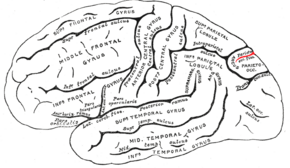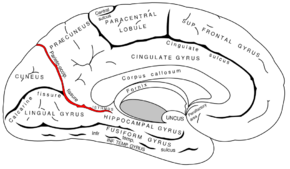Biology:Parieto-occipital sulcus
| Parieto-occipital sulcus | |
|---|---|
 Fig. 726: Lateral surface of left cerebral hemisphere, viewed from the side. | |
 Fig. 727: Medial surface of left cerebral hemisphere. | |
| Details | |
| Identifiers | |
| Latin | sulcus parietooccipitalis, fissura parietooccipitalis |
| Anatomical terms of neuroanatomy | |
In neuroanatomy, the parieto-occipital sulcus (also called the parieto-occipital fissure) is a deep sulcus in the cerebral cortex that marks the boundary between the cuneus and precuneus, and also between the parietal and occipital lobes. Only a small part can be seen on the lateral surface of the hemisphere, its chief part being on the medial surface.
The lateral part of the parieto-occipital sulcus (Fig. 726) is situated about 5 cm in front of the occipital pole of the hemisphere, and measures about 1.25 cm. in length.
The medial part of the parieto-occipital sulcus (Fig. 727) runs downward and forward as a deep cleft on the medial surface of the hemisphere, and joins the calcarine fissure below and behind the posterior end of the corpus callosum. In most cases, it contains a submerged gyrus.
Function
The parieto-occipital lobe has been found in various neuroimaging studies, including PET (positron-emission-tomography) studies,[1][2][3][4] and SPECT (single-photon emission computed tomography) studies,[5][6] to be involved along with the dorsolateral prefrontal cortex during planning.
Gallery
-
Animation of left cerebral hemisphere. Parieto-occipital sulcus shown in red.
-
Medial surface of right hemisphere. Parieto-occipital sulcus labeled at top right as "*"
-
Medial surface of left hemisphere. Parieto-occipital sulcus visible at top left.
-
Human brain dissection video (1 min 52 sec). Demonstrating location of parieto-occipital sulcus of left cerebral hemisphere.
References
- ↑ Owen, Adrian M.; Doyon, Julien; Petrides, Michael; Evans, Alan C. (1996). "Planning and Spatial Working Memory: a Positron Emission Tomography Study in Humans". European Journal of Neuroscience 8 (2): 353–364. doi:10.1111/j.1460-9568.1996.tb01219.x. PMID 8714706.
- ↑ Baker, S.C.; Rogers, R.D.; Owen, A.M.; Frith, C.D.; Dolan, R.J.; Frackowiak, R.S.J.; Robbins, T.W. (June 1996). "Neural Systems Engaged by Planning: a PET Study of the Tower of London Task". Neuropsychologia 34 (6): 515–526. doi:10.1016/0028-3932(95)00133-6. PMID 8736565. http://www.owenlab.uwo.ca/pdf/1996-Baker-Neuropsychologia-Neural%20systems%20engaged%20by%20planning%20a%20PET%20study%20of%20the%20Tower%20of%20London%20Task.pdf. Retrieved 18 June 2014.
- ↑ Dagher, Alain; Owen, Adrian M.; Boecker, Henning; Brooks, David J. (October 1999). "Mapping the Network for Planning: a Correlational PET activation study with the Tower of London Task". Brain 122 (10): 1973–1987. doi:10.1093/brain/122.10.1973. PMID 10506098.
- ↑ Rowe, J.B.; Owen, Adrian M.; Johnsrude, Ingrid S.; Passingham, R.E. (2001). "Imaging the Mental Components of a Planning Task". Neuropsychologia 39 (3): 315–327. doi:10.1016/S0028-3932(00)00109-3. PMID 11163609. http://uwo.ca/bmi/owenlab/pdf/2001-Rowe-Neuropsychologia-Imaging%20the%20mental%20components%20of%20a%20planning%20task.pdf. Retrieved 18 June 2014.
- ↑ Rezai, Karim; Andreasen, Nancy C.; Alliger, Randy; Cohen, Gregg; Swayze, Victor II; O'Leary, Daniel S. (June 1993). "The Neuropsychology of the Prefrontal Cortex". Archives of Neurology 50 (6): 636–642. doi:10.1001/archneur.1993.00540060066020. PMID 8503801. http://archneur.jamanetwork.com/article.aspx?articleid=592394. Retrieved 18 June 2014.
- ↑ Morris, R.G.; Ahmed, S.; Syed, G.M.; Toone, B.K. (December 1993). "Neural Correlates of Planning Ability: Frontal Lobe Activation during the Tower of London Test.". Neuropsychologia 31 (12): 1367–1378. doi:10.1016/0028-3932(93)90104-8. PMID 8127433.
External links
- "Anatomy diagram: 13048.000-3". Roche Lexicon - illustrated navigator. Elsevier. http://www.tk.de/rochelexikon/pics/s13048.000-3.html.
- https://web.archive.org/web/20070316043257/http://www2.umdnj.edu/~neuro/studyaid/Practical2000/Q30.htm
 |




